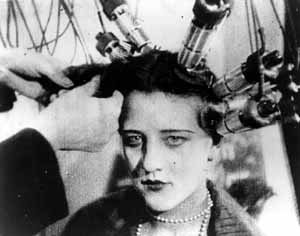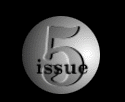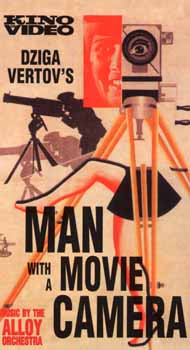
The kino-eye in Dziga Vertov's
Man With a Movie Camera.
(©1997 Kino on Video. All rights reserved.)
And foster he does. The Man With a Movie Camera is divided into nine
orchestral-type movements, and several of them use rapid-fire editing, wild
juxtapositions (e.g. blinking eyes with shutter blinds) and multiple exposures
to mesh workers with machines in a simultaneity of reverence and celebration.
Levers and wheels turn and workers synchronously turn with them. Later, Vertov
reveals more mechanical reality as he juxtaposes a woman getting her hair
washed with another washing clothes, and then shows a barber shaving a man, and
sharpening a razor's edge. The sequence ends with newspapers rifling along a
printing press, and a young woman packing cigarettes, watching the machine's
quick slap pressing, while smiling at her labor.
As Vertov revealed the joys of work, the rhythm of workers and machines, he
also felt that filmmaking (as a largely technological medium) was also a
component of that mechanical reality. In the aforementioned sequence of a
cigarette worker and her machine, Vertov also splices into the mise-en-scene
his wife and editor, Yelizavela Svilova. As shoes are shined and a woman gets
her hair cut and fingernails polished, an edit reveals Svilova rubbing emulsion
off the film strip, suggesting that polishing the beauty of cinema is
synchronous with the peoples' visit to the beauty salon. More importantly,
Svilova's appearance stitched into another montage (a woman sews, fabric linked
with thread, while Svilova edits, film threaded through a splicer) strongly
suggests that filmmaking is workmanlike, the perfect analog to the worker's
life.

Vertov's camera finds mechanical
imagery in the beauty salon.
(©1997 Kino on Video All rights reserved.)
Besides celebrating workers, machines, and filmmaking as constituting Soviet
reality, Vertov uses kino-eye to transcend the very reality he celebrates. In
a 1923 manifesto, Vertov wrote "I am kino-eye, I am mechanical eye, I, a
machine, show you the world as only I can see it." And he boldly asserted: "My
path leads to the creation of a fresh perception of the world I decipher in a
new way a world unknown to you." Again this ground-breaking film brings to
fruition Vertov's earlier vision of what cinema should be. His camera, in the
hands of brother Mikhail Kaufman, is never static; it travels where we can't--up
smokestacks, under train tracks--and through continuous explosions of cinematic
trickery--variable camera speeds, dissolves, split-screen effects, the use of
prismatic lenses, and tightly structured montage--Vertov transforms not only
reality, but traditional narrative cinema. He moves outside of Hollywood
storytelling (three-act structures, goal-oriented characters), and closer to an
absolute language of cinema that he seeks.
The film's middle section captures some of the absolute language of the
kino-eye. The sequence begins with a low-angle canted shot of a traffic light
turning. Then from on high, the camera visible frame right, kino-eye overlooks
a busy Moscow street. Cut to a joyous couple walking into a municipality,
where they sign a wedding registration. Kino-eye then returns to the previous
establishing shot, as the camera pans the street, and then cuts to the traffic
signal reversing. This switch cues a shift in mood which is reinforced as next
cut shows the camera, frame right, spinning around and portraying a darker side
to life's dialectics. Kino-eye now shows a disconsolate couple entering the
municipality to fill out a divorce registration. Their pending separation is
foregrounded in kino-eye's shot selection: an occasional two-shot mixed with
six separate shots of the woman, chin in her hands, and four separate shots of
the man, looking weary and angry. Kino-eye follows this with a prismatic image
of streetcars crossing in V-shaped diagonals and then offers more dialectics: a
crosscut sequence of automobiles heading to a funeral and an agonized woman,
awaiting the birth of her child. The sequence concludes with the cameraman
superimposed over a prismatic street, buildings leaning at weirdly oblique
angles, and in a graphic punctuation, a baby born from kino-eye's doctorly
point-of-view. In three minutes, Vertov's kino-eye has ordered material
reality in fresh, original ways, revealing a range of motion (high/low
compositions and stunning taboo images of the baby's birth) and emotion
(marriage/divorce; death/life).
The film's conclusion is aesthetically beautiful and ideologically committed.
Oddly, in the 1930s the Stalinists didn't think so. Vertov fell into disfavor
with their regime and this film and others were accused of formalist error, of
placing aesthetics ahead of ideological commitment. It's unfortunate that a
man who wanted to link the cinematic machine with the people could be so
mistrusted, because Man With a Movie Camera has a wonderfully rousing coda that
links spectators within the theatrical diegesis to their onscreen
counterparts (the film within the film). And as they watch their images
everything coalesces: machines (typewriter keys, spinning wheels, mechanical
spinners, streetcars) and people (walking the streets, driving cars, resting at
the beach) in rhythm, and in kinship. But perhaps the cameraman riding above
the sea of prismatically coalesced imagery bothered the Stalinists. Perhaps
they saw in that cameraman not formalist error but a brilliant representation
of the powerful kino-eye to not only see and know all then (1929), but to
possibly further see and expose a darkening future threatened by
totalitarianism.
Man With a Movie Camera is part of a new five-cassette video series from Kino on Video, called "The Soviet Avant Garde." Other films in the series include Vsevolod Pudovkin's Storm Over Asia and Deserter, Victor Turin's Turksib, and Lev Kuleshov's By the Law. Suggested retail price: $29.95 each. For more information, we suggest you check out the Kino Web site: http://www.kino.com.
|





